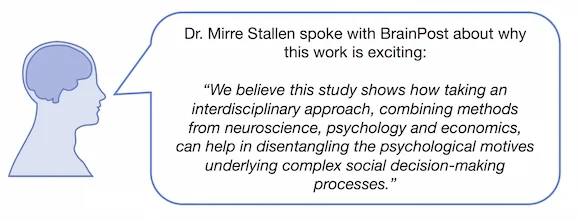Your Brain Reacting to Social Injustice
What's the science?
How do we perceive injustice? Many neuroimaging studies have looked at how we perceive the violation of social norms by analyzing brain activity while participants play a computer game. For example, participants might have the option to punish one player who is acting unfairly (e.g. stealing) towards another. Further, different hormones, like oxytocin, influence our social behaviour, suggesting they can play a role in our perception of injustice. This week in The Journal of Neuroscience, Stallen and colleagues performed a new set of experiments using brain imaging to analyze the perception of injustice.
How did they do it?
First, oxytocin was administered to half of the participants. Next, all participants underwent an fMRI brain scan, while playing three computer games: 1) Participants played against an opponent, called a ‘taker’. The taker had the opportunity to steal up to 100 chips away from the participant, and the participant could then punish the taker by giving up up to 100 of their own chips. For each chip they gave up 3 would be taken from the taker, (injustice happening to them) 2) Participants received 200 chips and observed a taker stealing chips from another player, and could then punish the taker (using up to 100 chips, 3 taken from the taker for each chip given up), (observing social injustice, punishing as a third party) and 3) Participants observed a taker stealing chips from another player, and could compensate the disadvantaged player using up to 100 chips (the disadvantaged player was given 3 chips per chip given up) (observing social injustice, compensating as a third party). Participants knew they would receive real monetary compensation after the games according to their performance, and all games were anonymous.
What did they find?
Participants who received oxytocin were more likely to dole out small punishments, frequently, to a taker who took chips from the participant or another player, versus participants who did not receive oxytocin. When the authors compared trials in which a participant doled out punishment to the taker versus compensating the disadvantaged player, there was greater activity in the ventral striatum -- a brain region involved in processing rewards. The decision to administer punishment was associated with activity in the anterior insula -- a brain region involved in “gut feelings” and decision making involving risk. Activity in the amygdala, a brain region associated with affective arousal, was correlated with the severity of punishment administered but only in experiment #2, when participants observed a taker behaving unfairly towards someone else.
What's the impact?
This is the first study to assess the perception of social justice in situations where an individual is experiencing injustice firsthand compared to observing injustice as a third party. This study suggests two distinct brain mechanisms might be at play during these unjust situations.
A word of caution: Different brain regions are activated in many different situations. Just because a brain region is known to be activated during reward, for example, does not necessarily mean that brain region will always be active during reward processing.
M. Stallen et al., Neurobiological Mechanisms of Responding to Injustice. Journal of Neuroscience. (2018). Access the original scientific publication here.





